
Flight Lieutenant Ben Pickering (left) and Squadran Leader Adam Palmer (right) Photo: Davina Zimmer
The Defence Force's Antarctic rescue mission involved hot refuelling, night vision goggles, minus 30 degree temperatures and the black hole effect.
Just two hours into a dangerous rescue mission to Antarctica, the crew on board the Royal New Zealand Defence Force super hercules hit their first snag.
They were told that Christchurch, the designated airport they would divert to if they had to turn around, was too risky for landing.
Freezing fog had already ruled out Invercargill and Dunedin, and now Christchurch. Next on the list was Wellington.
But Wellington's runway was closed for maintenance.
Today The Detail hears how the sole job of one of the two co-pilots on board was to keep watch on the ever-changing, unpredictable weather and find a new destination for the emergency turnaround.
The closed runway problem was sorted, but not before the mission leader got involved from Christchurch and phone calls were made.
It was one of many risks that had to be weighed up against the purpose of the mission - saving a life.
Defence got the call for help from the US National Science Foundation at McMurdo Station to pick up one person who needed urgent medical care, and two others who were also ill.
Squadron leader Adam Palmer was in charge of the mission - his first time in the lead - and watched every moment on his laptop from Christchurch.
He says that the dangers rescuers face could be "any number of things".

The NZDF's C-130J-30 Super Hercules. Photo: Davina Zimmer
"We talk about almost a perfect triangle. You need the aircraft to play the game, the weather in Antarctica to be good, the weather in New Zealand to be good, as well as the weather en route."
But the greatest danger is that the rescue plane goes beyond the point of safe return and the weather turns bad.
The crew took off from Christchurch knowing the weather was not looking good for landing at Phoenix Airfield at McMurdo Station.
"Initially there were reports that there was going to be snow and big reductions in visibility," co-pilot flight lieutenant Ben Pickering says.
The weather forecast kept changing on the flight down but in a positive way, he says, and the poor conditions initially predicted on the runway never eventuated.
From their airbase at Whenuapai, Palmer and Pickering explain the preparations and planning that took place in the five days from the first call to the defence force for help, to take off from Christchurch.
Even though a patient was seriously ill, Palmer says a number of things had to be put in place to minimise the risk, including creating a runway at McMurdo to make landing safe.
"Because it is winter at the moment they haven't maintained the runway to the standard they normally would during the summer season," he says.
A team from the US base had to clear excess snow, groom and compact the 10,000 foot runway.
In its message of praise for the "heroic" mission, the US Embassy says it was a feat that took precision and extraordinary skill. In typical low-key fashion, Pickering describes the landing by captain Andrew Sledger as "good".
Pickering says night vision goggles were used for much of the flight but the clarity of the airfield meant they could remove them for landing - but that in itself was a danger.
"When you take the goggles off suddenly there is no terrain definition. So you get this effect called the black hole effect where if you can imagine the outline of a runway lit up and there's just absolutely nothing around it except for darkness, it just feels like you're floating in space and it can cause some optical illustions where you feel like you're low."
Despite the safe landing, there were more risks to come, including "hot refuelling" the plane in minus 30 degrees Celsius while the patients were loaded on board.
The US Embassy says the NZDF delivered on a mission that was "nothing short of heroic" and that tested "every ounce of skill and bravery".
Palmer says it is the riskiest operation he has overseen but also "massively rewarding".
"Having had the J (hercules) for 11 months to now go and do this is awesome for the team."
Pickering says it is the toughest real-life mission of his career so far.
"When you see the pictures of us landing - from the outside - onto the runway, it would be a pretty significant moment if you needed to leave Antarctica seeing a 730 land ready to pick you up. For me that was pretty cool."
Check out how to listen to and follow The Detail here.
You can also stay up-to-date by liking us on Facebook or following us on Twitter.





